Top News
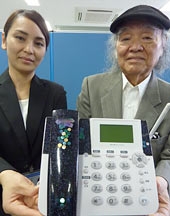
March 23, 2012 Ryukyu Shimpo
Willcom Okinawa, a PHS company in Naha, has produced an Okinawan traditional lacquered Ie-Denwa, a fixed-line style PHS, as one of their products. The receiver is designed using raden, a Japanese decorative technique, featuring a design of great green turban shells. Koin Maeda, a lacquer artist and a holder of the status of prefectural intangible cultural asset, helped to make the product.
Ie-Denwa is a PHS that has the same design of land-line phone. No installation is necessary, and it can be battery-powered so you can also carry around it outside.
The lacquering on the receiver and part of the PHS itself uses a design with the grape and squirrel motif of the raden style. According to Maeda, this is one of the representative designs for Ryukyuan lacquer-work. Maeda visited the Ryukyu Shimpo office and said, “We can use it not only as a telephone, but also as a craft item. By utilizing traditional techniques for this modern device, everyone can feel closer to traditional culture.”
The price is 130000 yen, including tax. They produce the product to order. For further details, call Willcom Okinawa at (0120) 546300.
(English translation by T&CT, Lima Tokumori and Mark Ealey)
Go To Japanese
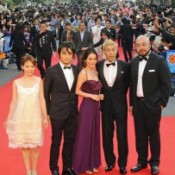
March 25, 2012 Ryukyu Shimpo
On March 24, the 4th Okinawa International Movie Festival commenced at Ginowan and other places around Okinawa. About 350 movie stars and artists, including a comedy duo from Okinawa and popular comedians from the main islands of Japan, walked on the 300-meter long red carpet set up around Ginowan Tropical Beach prior to the opening ceremony. The festival is showcasing a total of 102 features from 15 countries and regions. At the main venue, a film display began using the world’s largest mobile outdoor screen, which was installed for the first time in East Asia. The film and talk show started at Sakurazaka Theater in Naha.
Comedian Koji Imada, comedy duo Slim Club and Garage Sale from Okinawa appeared on the red carpet. Many fans converged on the carpet calling out the names of the celebrities. The comedians responded in a relaxed and friendly manner by shaking people’s hands and giving signatures. Shinya Akamine, a 12 year-old from Tomigusuku, who came with his mother, said with a smile, “It was fun to meet Mr. Imada.”
On March 25, a fashion show was included in the Okinawa International Movie Festival for the first time. Popular models such as Anna Tsuchiya and entertainers gathered at the fashion show and the musical performance. The feature comedy movie Hi-Zai directed by Shuhei Fukunaga, who is from Okinawa, was also screened.
(English translation by T&CT, Mark Ealey)
Go To Japanese

Go To Video
March 23, 2012 Ryukyu Shimpo
On March 21, in the Kadena Ammunition Depot, 113 liters of diesel fuel leaked out of an underground fuel tank that is not currently being used. On March 22, through Okinawa Defense Bureau, Kadena Airbase officials informed the Okinawa Prefectural Government (OPG) and the municipalities around the base of the accident. According to the Enterprise Bureau, which functions as the Water Supply organization of the OPG, the fuel did not leak into the Hija River. Local residents are concerned about the effectiveness of measures to prevent a recurrence of fuel leaks and the impact on the farmland because the same type of fuel leak also occurred last August.
The fuel leak occurred about 200 meters from the gate of kudoku Farmers, in Kadena Town. This is arable land used by locals but belonging to the U.S. military. A spokesperson of Kadena Airbase commented to the Ryukyu Shimpo that the military will dig up the soil polluted by the fuel and will consider removing the underground fuel tank itself. The military authorities state that there will be no risk to residents, because the range that the fuel soaked is limited and away from the boundaries between the base and the local areas. They found no effect on the wells located in the base.
Upon receiving the news from the base of a fuel leak, the Kadena Municipal Office requested that the base conduct an on-site inspection through the Defense Agency. Currently, the Defense Agency is negotiating with the U.S. military authorities to permit entry for Municipal Office staff. Hiroshi Toyama the mayor of Kadena said, “This is very regrettable. What is the U.S. military doing to prevent the recurrence of fuel leaks? We need to inspect the fuel tank in the ammunition depot. We are concerned about the impact on farmland and on the Hija River, and about the possibility of fire.”
Toshio Shimabukuro, the head of Higashi neighborhood community association of Kadena said, “Farmers are worried about accidents. Base officials should move quicker to contact residents about these things, and they should take effective measures to prevent recurrence of such accidents.”
(English translation by T&CT, Mark Ealey)
Go To Japanese
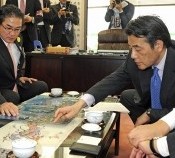
March 18, 2012 Ryukyu Shimpo
Deputy Prime Minister Katsuya Okada, who visited Okinawa for the first time since he was appointed, met Ginowan mayor Atsushi Sakima in the municipal office on March 17. Okada insisted that maintenance and repair work on U.S. Marine Corps Air Station Futenma is necessary in order to continue using the base, saying, “The more run down the facilities become, the more likely it is that accidents will occur.” In that context, Okada tried to obtain the consent of Okinawans who are worried that Futenma will become a permanent fixture, asserting that, “The Japanese government should look at maintenance and repair work for the base quite separately from that matter.” Okada and Sakima agreed that they want to avoid the situation in which the base becomes a permanent fixture.
While Okada asserted that the Japan-U.S. agreement by which the governments of Japan and the United States will relocate Futenma Air Station to Henoko, Nago will go ahead, he said, “The Japanese and U.S. governments will strive to eliminate the dangers posed by the base until we actually relocate the base.”
With regard to the situation in which the U.S. military does not comply with agreements on aircraft noise abatement countermeasures prohibiting military aircraft from flying during the early morning and night hours, Okada said, “We would like the U.S. government to keep its promises. If we make exceptions to the agreements, they will not work anymore. We strongly urge the U.S. government to comply with established agreements.”
Before going back to Tokyo, Okada held a press conference at a hotel in Naha. With regard to the MV-22 Osprey vertical take-off and landing transport aircraft that are scheduled to be deployed at Futenma Air Station this year, Okada said, ” Judged from data provided by the United States, the frequency of accidents involving the Osprey, makes us believe that their deployment will not lead to an increase in the burden on Okinawa of hosting U.S. forces.”
With regard to the Futenma relocation issue, Okada asserted, “The Japanese government will move in keeping with the Japan-U.S. alliance and implement the current plan.” On the matter of local opposition to the plan, Okada said, “We would like to foster a trusting relationship in order to secure local consent and will handle the situation in good faith.”
At the meeting, Sakima demanded the early return of Futenma Air Station, the elimination of dangers posed by the base and the upgrade of Route 11.
Before his meeting with Sakima, Okada met Okinawa Governor Hirokazu Nakaima at a hotel in Naha. Although it was unofficial, Nakaima and Okada were reported to exchange opinions regarding the reduction of the burden on Okinawa of hosting U.S. forces and the need to swiftly construct a second runway at Naha Airport.
(English translation by T&CT, Mark Ealey)
Go To Japanese
March 20, 2012 Ryukyu Shimpo
On March 19, in a briefing session of the 2011 fiscal year held at the Okinawa Industry Support Center in Naha the Bankoku-Iryo-Shinryo Council reported that the University of the Ryukyus Hospital has arranged to conclude an agreement with the China-Japan Friendship Hospital in Beijing, the biggest national hospital in China. The agreement is designed to promote exchange of technology and human resources. The council aims to boost medical exchange between the two nations and create medical tours through cooperation between the public and private sectors.
According to the council, there are many officials in China who are interested in Okinawa because of the shortage of rehabilitation doctors and the limited medical technology in China. It is expected that the combination of medical tours for rehabilitation and sports camps taking advantage of the Okinawan climate have potential to succeed.
The China-Japan Friendship Hospital operates since 1984 thanks to support from official development assistance from the Japanese government. It has 1500 beds, and receives two million outpatient visits per year. The hospital has exchanges with over 30 top universities in the world including Harvard University.
In January, director of the University Hospital Sadayuki Murayama visited the China-Japan Friendship Hospital to coordinate matters, and executive officers from the China-Japan Friendship Hospital will be invited to Okinawa in May. The specific content of the exchange has not yet been decided upon, but they will continue to work on the agreement and hope to conclude it by the end of the year.
Morijiro Ishihara, the network manager of the council, said, “International medical exchanges will be main focus at the first stage, and as we deepen the relationship, I hope that private exchanges such as medical tourism also develop.”
(English translation by T&CT, Lima Tokumori and Mark Ealey)
Go To Japanese
March 20, 2012 Ryukyu Shimpo
From March 1, the Kadena Air Base north runway, which had been the focus of construction work, became operational again, causing further aircraft noise for the neighborhood. In the closest district to the north runway, at a place called Yara in Kadena Town, a noise level of over 100 decibels has been recorded on a daily basis. In the morning of March 17, ignoring local residents’ requests to desist, aircraft deployed in Kadena including F-15 fighters, took off during a graduation ceremony at Yara Elementary School and Kadena Elementary School, with the resulting noise provoking anger among people involved in local education.
Kadena Town PTA will approach the Okinawa Defense Bureau about the intensified level of noise. Attending the ceremony at Yara Elementary School, President of PTA, Takeshi Ishiki said, “It was noisy on the day of graduation. The military of course must have their own schedule of operations, but I want them to refrain from flying their planes at times when we need to offer children a quiet educational environment. I would like to see a ban on flights during ceremonies and tests.”
A noise level from takeoffs of around 90 decibels was reported 16 times from 9:00am to 11:30am when the ceremony was carried out.
Since October 2010, repair work on two runways has been carried out at Kadena Air Base. When the south runway was being worked on, the military operated only on the north runway, which is located closer to the residential area, and this increased the level of noise in Kadena Town.
Mayor Hiroshi Toyama said, “Until last month, the noise level was lower because of the runway construction and the relocation of the F-15 flight-training, but the noise is back now after the work on the runway was completed. I would like to request that the government do something tangible to ease the burden on the local residents.”
(English translation by T&CT, Megumi Chibana and Mark Ealey)
Go To Japanese
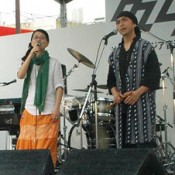
March 19, 2012 Ryukyu Shimpo
To commemorate the 40th anniversary of Okinawa’s reversion to Japanese sovereignty, Okinawa decided upon Tinsagunu hana as the prefecture’s favorite song. Singer Erika Sunakawa and Daiichi Hirata, the director general of Department of Culture, Tourism, and Sports Okinawa Prefectural Government, announced this and sang the song at the Okinawa International Asia Music Festival 2012.
The idea of choosing Okinawa’s favorite song is designed to help provide a sense of unity and to build stronger pride and deeper attachment to the homeland. Committee members used a questionnaire, which saw the song selected as “the favorite.” Tinsagunu hana was chosen for two reasons, one because it has been sung over a period of years, and two because the lyrics were written in Uchinaguchi and have a profound meaning. Director Hirata also played a traditional Okinawan flute to the music. He commented, “Let’s sing this song to reflect this historical event and to mark the significant milestone of the 40th anniversary.”
(English translation by T&CT, Shinako Oyakawa and Mark Ealey)
Go To Japanese
March 16, 2012 Ryukyu Shimpo
From March 9, a Ryukyuan Awamori lecture offered by the Awamori Meister Association started at the Ching Yun University in Taiwan.
On March 15, at the Ryukyu Shimpo office, Katsunobu Shingaki, the chairperson of the association, explained, saying, “In the first lesson, students took a keen interest in the history and culture of awamori in Okinawa. They then focused on a tasting session. I sensed a strong level of enthusiasm for learning about something in new field.” Arakaki continued to say, “I believe that an appreciation of awamori will increase in Taiwan by studying hard through the year.” Manabu Shiokawa, the managing director of the association, will serve as a lecturer. The class will be held once a month with two periods of 90 minutes each. Students will learn about basic matters of Okinawan culture and the manufacturing process of awamori in the first period, and then receive a practical lesson in which they taste three types of awamori in the second period.
(English translation by T&CT, Lima Tokumori and Mark Ealey)
Go To Japanese
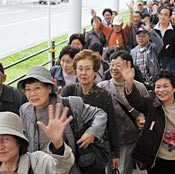
March 16, 2012 Ryukyu Shimpo
In the afternoon on March 15, 100 people arrived at Naha Airport on an invited tour for the elderly living in areas affected by the Great East Japan Earthquake. The Okinawa Prefectural Government, the Great East Japan Earthquake Support and Cooperation Council and the Okinawa Prefectural Council of Social Welfare organized the tour. The participants are all 65 years old or older. As part of reconstruction support for the affected areas, the tour is designed to provide encouragement to elderly people currently living in temporary housing because of the accident at the Tokyo Electric Power Company Fukushima Daiichi Nuclear Power Plant. During the four-day trip, the guests will visit sightseeing spots and have a rest in Okinawa’s warm climate.
At the airport, Okinawa Vice Governor Kanetoshi Yoseda and members of the Okinawa Jangara-Kai, a group of evacuees from Fukushima to Okinawa, greeted the guests. The leader of the tour, Susumi Yamasawa, the vice chairperson of the Soma City Council of Social Welfare, said, “A couple of days ago, the temperature plunged to below zero in Fukushima. Okinawa is a nice, warm place. I really appreciate the people of Okinawa organizing this trip for us.”
Tomeko Otani has been looking forward to coming to Okinawa, saying, “I feel like I’m dreaming.”
Masayoshi and Mineko Osawa said, “The tsunami swept away our house and we are still living in temporary housing. We want to create many pleasant memories of our stay here in Okinawa.”
From March 16, they are scheduled to visit Shurijo Castle Park and the Okinawa Churaumi Aquarium, and will attend a party with the Okinawa Jangara-Kai.
(English translation by T&CT, Lima Tokumori and Mark Ealey)
Go To Japanese
March 15, 2012 Ryukyu Shimpo
The Committee on the Elimination of Racial Discrimination (CERD) in Geneva has decided to send a letter to the Japanese government requesting an explanation of the situation regarding the plan to relocate the U.S. Marine Corps Air Station Futenma to Henoko, Nago, but the Japanese government denies any discrimination against Okinawan people and asserts that the current plan is the best option.
A representative of the Ministry of Foreign Affairs revealed this at the Liberal Democratic Party’s Foreign Affairs Division meeting held on March 14.
The head of the division, Itsunori Onodera, pointed out that, “If CERD deems that the Japanese government has been discriminatory towards the Okinawan people with regard to the Futenma issue, I suspect that that could have a considerable impact on the current relocation plan.”
The representative of the ministry said, “Although we cannot say that CERD’s judgment will have an impact on the current plan, we would like to explain to them that the Japanese and U.S. governments have been sincere in their efforts to implement the plan. We would really like to avoid a situation in which CERD makes a recommendation to us.”
In the letter, CERD stated, “Although the Ryukyuan people and other Japanese living in Okinawa consider that the relocation of the Futenma Air Station to Henoko could have a hugely negative impact on the regional environment and living conditions, and have strongly resisted its implementation and have criticized the Japanese and the U.S. governments, both the governments still adhere to the plan. We are concerned about this situation.” With regard to the planned new helipad construction at Takae in Higashi Village, CERD stated, “Residents and the local assembly members have continued to oppose the construction. We are concerned about this.”
The Japanese government is asked to reply to the letter by the end of July. CERD is scheduled to meet in August to monitor the Japanese government’s compliance with the International Convention on the Elimination of All Forms of Racial Discrimination. Depending on how the situation develops, CERD will consider making a recommendation to the Japanese government. This recommendation would not be legally binding.
(English translation by T&CT, Mark Ealey)
Go To Japanese
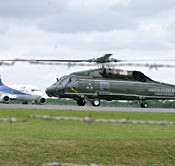
March 14, 2012 Ryukyu Shimpo
An HH-60H helicopter and a C-12 fixed wing aircraft belonging to the U.S. naval forces in Japan, landed at Ishigaki Airport, a civilian facility, on March 13. Five military personnel transferred from the C-12 to the helicopter, and flew to a U.S. naval vessel. The HH-60H helicopter is used to transport the commander of the U.S. 7th Fleet and it is possible that he was on board. Although the Okinawa Prefectural Government (OPG) and Ishigaki City authorities had requested that the U.S. military refrain from using the airport except in emergency situations, the U.S. naval forces went ahead and used it. Peace groups held protest rallies around the airport to oppose its use by the military. This is the first time that U.S. military aircraft have arrived at the airport since November 2008.
The HH-60H helicopter landed at the airport at 12:45pm, about 30 minutes earlier than the time the U.S. military had told the OPG. The helicopter was seen circling over the surrounding urban area before landing. After five personnel transferred to the helicopter, it took off from the airport at around 1:50pm.
The C-12 flew from the Naval Air Facility Atsugi in Kanagawa Prefecture and arrived at Ishigaki Airport at around 1:23pm. The aircraft transferred personnel to the helicopter and then flew back to Atsugi before 2:00pm.
Wataro Rai, who belongs to RIMPEACE, a citizen group that monitors the movement of U.S. forces in Japan, said, “I suspect that the commander of the U.S. 7th Fleet, who had been in Atsugi, flew to the U.S.S. Blue Ridge, which is deployed in the East China Sea, via Ishigaki Airport. It is very likely that the U.S. Navy used the airport because it is the nearest airport to the Blue Ridge.”
Ishigaki Mayor Yoshitaka Nakayama said, “Military use of the airport is unacceptable.” He went on to say, “As it stands at the moment, U.S. forces use the airport even though we request them to refrain from using it. We need to request that the Japanese and U.S. governments not only prohibit U.S. forces from using the airport but also drastically revise the Status of Forces Agreement, which permits the military use of civilian airports.”
According to the Ministry of Land, Infrastructure, Transport and Tourism, there was no impact on flights of civilian airplanes.
Okinawa governor expresses dismay at the incident
With regard to an HH-60H helicopter and a C-12 fixed wing aircraft of the U.S. naval forces using Ishigaki Airport, Okinawa governor Hirokazu Nakaima said, “It is unfortunate that U.S. forces used the Ishigaki Airport despite our repeated requests for them to refrain from using civilian airports.” He went on to say, “I strongly request that the U.S. forces do not to use civilian airports except in emergency situations. We need to ensure that there are smooth and safe flights of civilian aircraft.”
(English translation by T&CT, Mark Ealey)
Go To Japanese







 Webcam(Kokusai Street)
Webcam(Kokusai Street)


